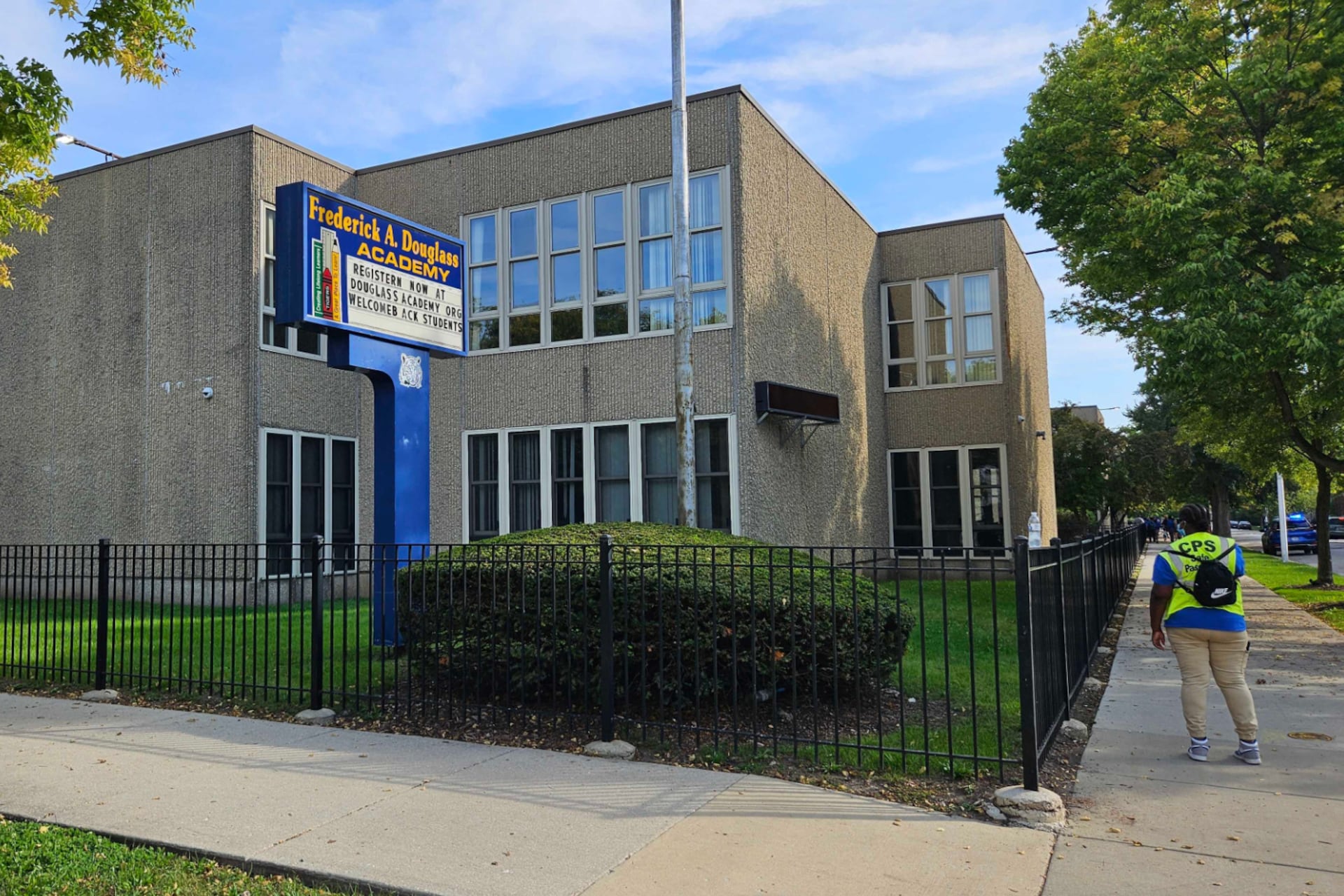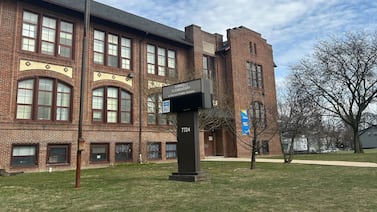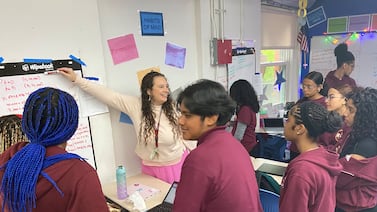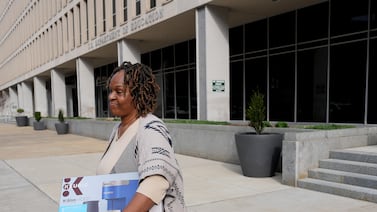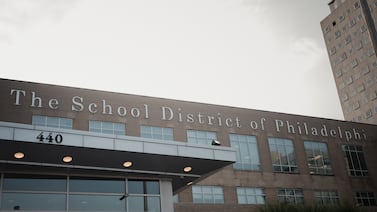Dismissal time at many high schools is often a crowded scene, with school buses and parents jockeying for parking and kids spilling out in every direction.
But at Frederick Douglass Academy High School, 543 N. Waller Ave. in Austin, just 33 students emerge from the school when classes wrap at 3 p.m. A student body that’s roughly the size of a single English class roams the campus briefly before heading home.
“This is so boring. There is nobody in here,” one student said after leaving Douglass on a recent school day.
At one point a beacon of academic excellence and point of pride for West Siders, Douglass’ low enrollment is now unsurprising to students and neighbors, they said. It’s indicative of the disinvestment West Side residents have suffered for generations, which has led to an exodus of local kids going elsewhere for school.
During the 2007-08 school year — when Douglass converted from a middle school to a high school — there were 561 students, Chicago Public Schools historic enrollment data shows. By the 2015-16 school year, enrollment dropped to 234 students, a nearly 60 percent decrease.
Since 2007, enrollment at Douglass has dropped about 94 percent.
The only community member or parent on Douglass’ Local School Council is Catherine Jones, leaving six open seats for parent representatives and one for community members.
Jones, an Austin resident, has watched the school’s enrollment diminish but said she would not stop advocating for the school’s improvement as it falls into decline from a lack of students and needed repairs.
“These kids deserve a good school, and it feels as if nobody hears us,” she said. “I won’t stop fighting for it.”
Chicago Public Schools said Douglass is not in jeopardy of closing, and efforts are underway to boost under-enrolled schools.
Douglass Principal Michael Durr did not respond to repeated requests for comment, nor did other staff and faculty at the school.
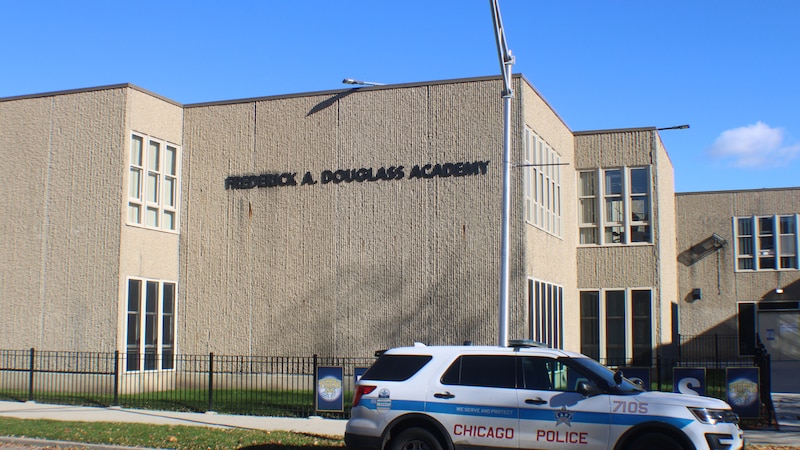
Ongoing fallout of Chicago’s closed schools
Statistically, the low enrollment means Douglass has some of the highest per-pupil spending in the district.
The high school is spending just over $68,000 per student compared to the district average of $18,287, statistics from the Illinois State Board of Education show.
Douglass’ spending per student is up 20 percent this year, according to the state.
The only CPS school to spend more on a per-student basis is Simpson Academy High School for Young Women, a small alternative high school on the Near West Side. Simpson Academy has 27 students and spends over $94,000 per student, state records show.
Though graduation rates are up in recent years, the increase in funding hasn’t led to the expansion or creation of certain advantageous programs for students, such as STEM classes and extracurricular activities, said Hal Woods, chief of policy for education nonprofit Kids First Chicago.
The school’s lack of resources, plus the decline in the city’s Black population, have led to fewer students attending neighborhood schools, according to neighbors and statistics.
Fifty-eight percent of West Side high school students attended school outside of the district’s West Side region in the 2022-23 school year, according to the Chicago Public School’s Annual Regional Analysis.
Of those leaving the West Side for high school, the majority head to the Far Northwest Side and Near West Side, according to the CPS regional analysis.
Bradley Johnson, chief community officer for youth development group BUILD Inc., said many of the problems with Douglass extend to inequalities the West Side has faced for decades. These include drug arrests, the savings and loan crisis of the ‘90s that lost billions for bank customers, the 2008 financial crash, and the closure of 50 schools in 2013 under Mayor Rahm Emanuel.
Four of the closed schools were in Austin, including Key Elementary, just across from Douglass. CPS sold the building in 2018 to The Field School, a private Christian institution.
Emanuel justified the closings by saying under-enrolled, low-performing and crumbling schools did not best serve kids.
A WBEZ-Sun-Times investigation showed the closures largely did not deliver on its promises that students would be better off elsewhere, their new schools would be improved, and their old school buildings would be overhauled.
A Chalkbeat investigation showed that roughly one-third of the students who attended closed schools transferred out of CPS entirely. Those families who left CPS after their schools closed dried up pipelines for local high schools. Families and advocates worried the school closures would exacerbate displacement and disinvestment in segregated Black neighborhoods.
An Austin native, Johnson said access to local resources begins to decline after elementary school, and high school recruitment is lacking due to the absence of things such as advanced placement classes and afterschool programs like sports or music.
“You have vastly different outcomes in life and in your education based on your ZIP code. They aren’t recruiting because of their reputation as a school without resources,” he said. “Equitable access to resources is the key, and this is a citywide issue.”
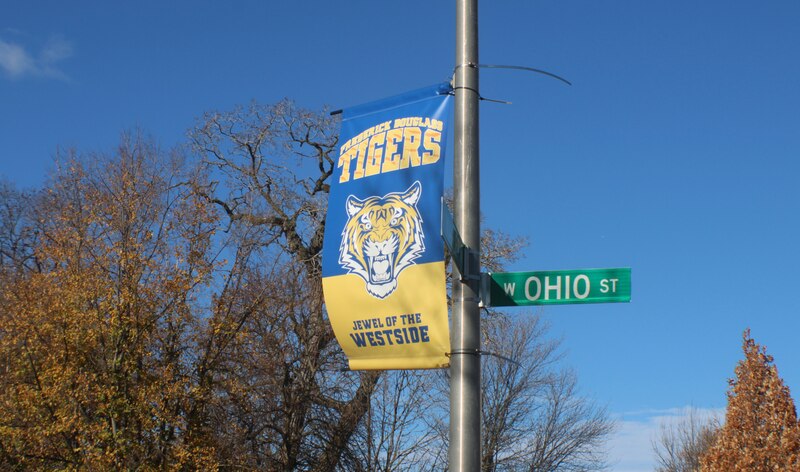
If attendance at Douglass doesn’t improve, Jones and others fear that the school could be forced to close, a prospect that has concerned parents at the school since at least 2017.
Ald. Chris Taliaferro (29th), whose ward includes Douglass, acknowledged the lack of students as a problem but said closing the school would only exacerbate the situation and further remove resources from the neighborhood.
“Closing schools is never good for the community. Doing so would only further disrupt the education of the students,” he said.
Asked about the low attendance of the school, a CPS spokesperson said the district would abide by the moratorium on closing public schools, a state mandate that expires in January 2025.
“We would avoid speculation on hypothetical future closures that have not been proposed and are not up for consideration by the Board [of Education],” the spokesperson said.
CPS is increasing the Equity Grant program from $50 million in this year to $55 million next year to stabilize funding for smaller and under-enrolled schools, mostly on the South and West sides.
The district also plans to update its Opportunity Index, a formula used by CPS to identify barriers to success such as race, income, education, health, and other factors when making certain funding and staff allocation decisions, the spokesperson said.
“By applying the updated Opportunity Index to allocate additional teacher positions, instructional coaches, counselors and other staff positions, the District can ensure that the families who are most impacted by inequity have additional support to create strong, vibrant and healthy school communities,” the CPS representative said.
The issues that have led to the situation at Douglass have unfolded for years. It will take a long-term strategy to fix it, Woods said.
“This is not a problem you can’t solve in one year,” Woods said. “The schools are still dealing with the fallout of the school closures a decade ago. CPS should listen to the broader community for what their needs are.”
This story was originally published by Block Club Chicago.

